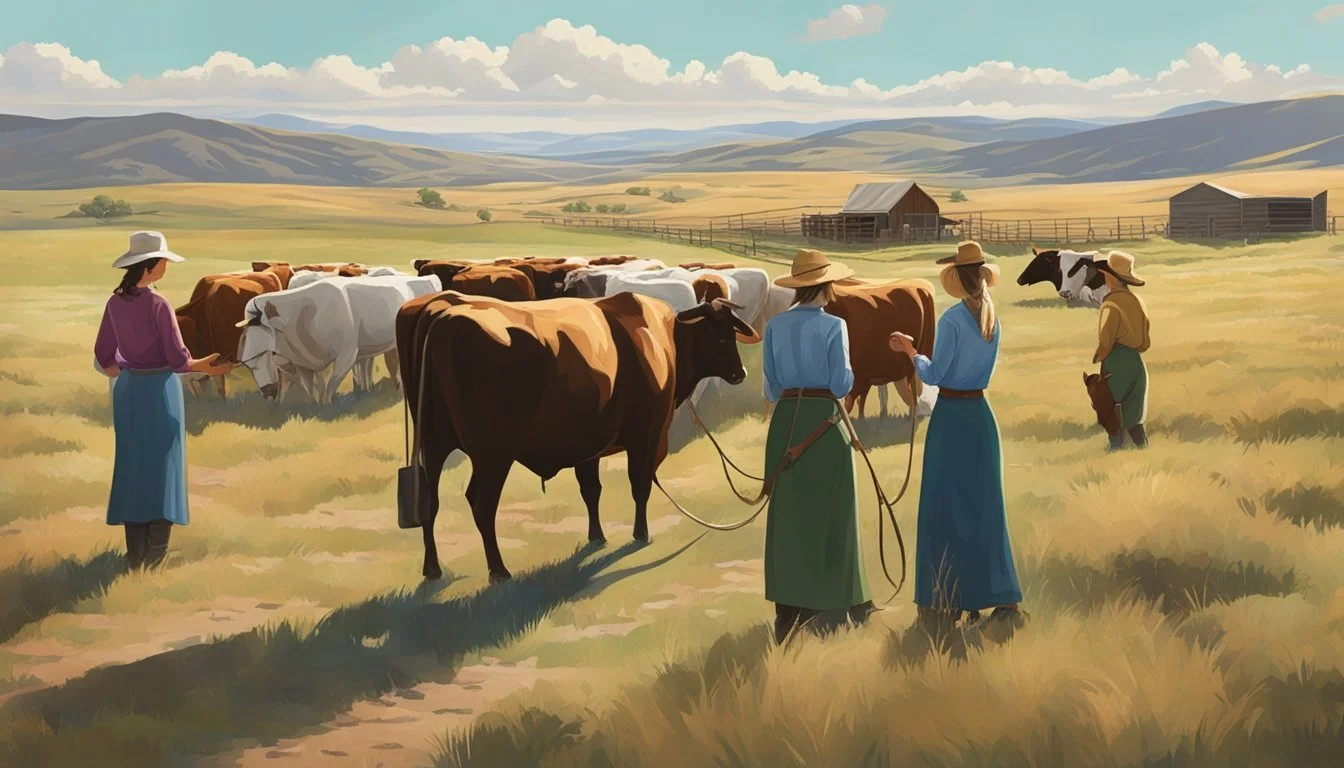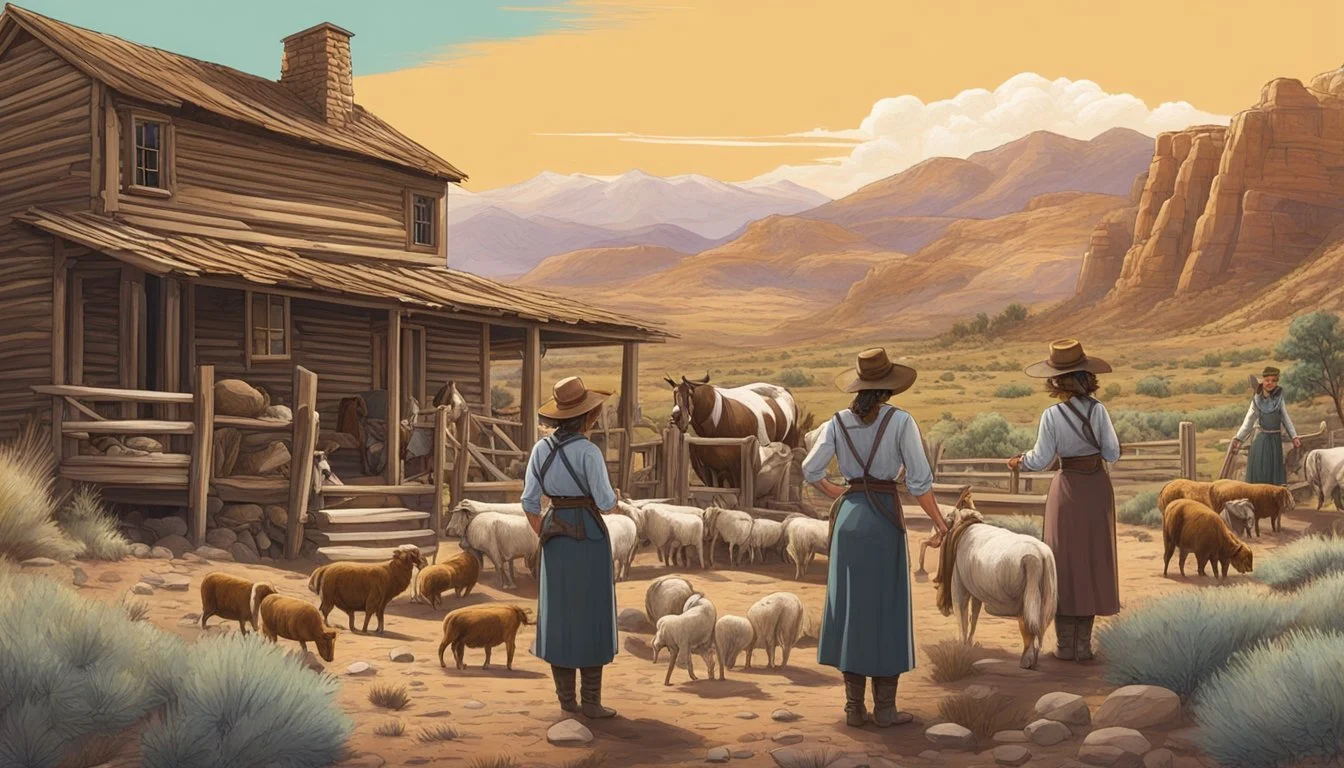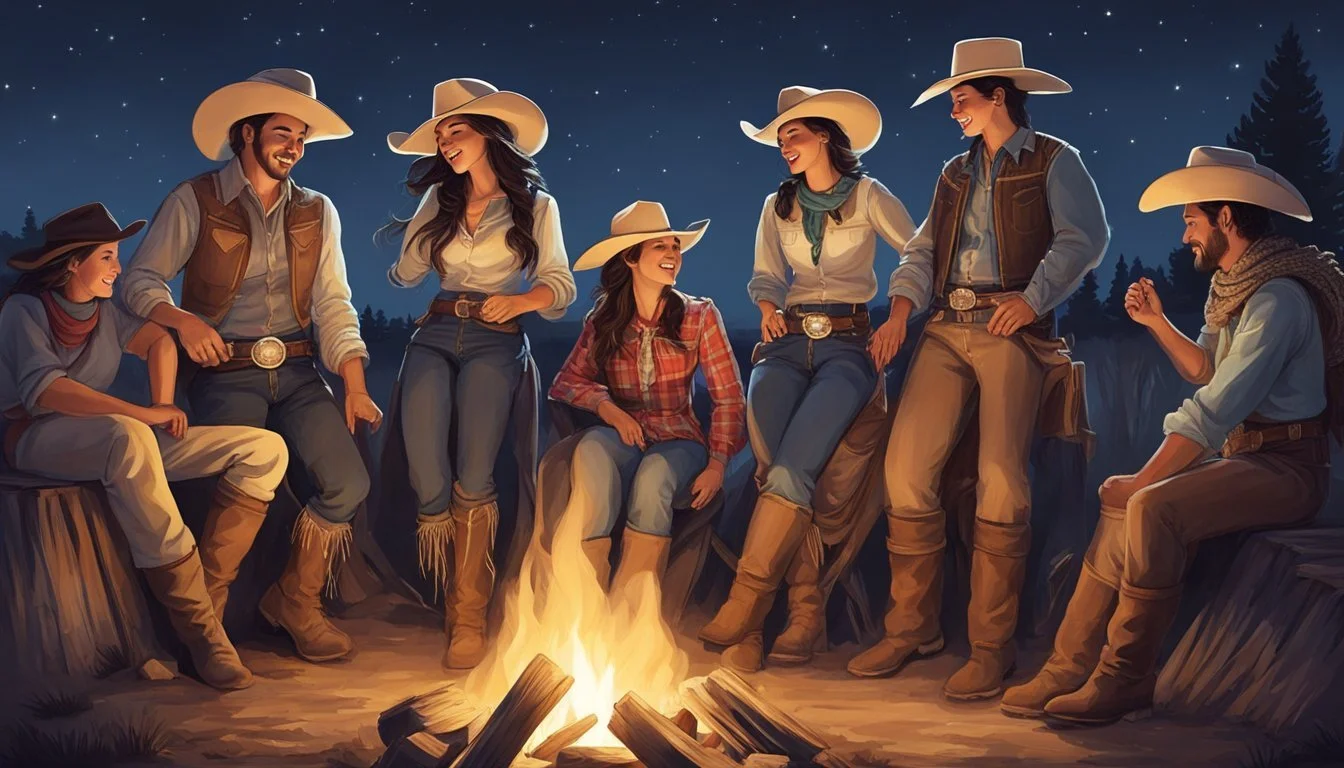Women in Cowboy Culture
The Untold Stories of Female Empowerment and Tradition
The narrative of women in cowboy culture is a tapestry of diverse, untold stories that challenge the traditional image of the Old West. While the American West is often characterized by the rough male cowboy figure, women played a significant role in shaping this iconic era. These women ranged from those who worked alongside men in the demanding life of cattle ranches to those who boldly broke societal norms to forge their distinct path in a predominantly male-dominated sphere.
The contribution of women to cowboy culture extends beyond hard labor and ranch work; they were also essential in their communities, taking on responsibilities that supported the cultural and economic development of the West. African American women, whose experiences have been less documented, faced the dual challenges of gender biases and racial discrimination, yet many thrived and found freedom in the open, albeit unyielding, landscapes of the Western frontier.
These pioneering women's stories offer a broader, more inclusive view of Western history. As we uncover these narratives, we gain a greater understanding and appreciation for the female figures who left an indelible mark on the cowboy legacy and contributed significantly to the rich tapestry of America's history.
Historical Context of Women in the American West
The women of the American West in the 19th century faced a unique set of challenges and opportunities. As pioneers, they contributed to the settlement and development of the frontier, shaping the cultural and economic landscape of the West.
Life on the Frontier
Life on the Frontier was a test of resilience and adaptability. In the 19th Century, women had to navigate a life that was often isolated and harsh. The typical image of men taming the wild West overlooks the fact that women were equally essential to the settling of the frontier. They managed households, provided medical care, and often undertook manual labor to support their families. The experience varied widely, however, with factors such as ethnicity, class, and location significantly influencing daily life.
The Rise of Ranching and Cattle Drives
During the Rise of Ranching and Cattle Drives, women's roles were often invisible in mainstream narratives. Despite this, they were integral in these operations, especially in regions like Texas and Kansas, which became hubs of the cattle industry. Women on ranches often managed the financial books, tended to gardens and livestock, and provided crucial logistical support for cattle drives that moved thousands of heads of cattle across the American West.
Tasks in ranching women might undertake:
Financial management
Food production and preservation
Livestock care
Medical aid on ranches and trails
Women's Roles During the Civil War
During the Civil War, some women in the South took on roles that were critical to both the war effort and their communities. With many men away fighting, women oversaw plantations and settlements, some even serving as makeshift nurses or engaging in battles. The conflict, while mostly concentrated in the East, reverberated throughout the country, affecting economic and social conditions in the West. After the war, many Southern women migrated westward, seeking new beginnings and becoming influential in the post-war expansion into the Western territories.
The Role of Women in Cowboy Culture
Women played multifaceted and vital roles within cowboy culture, transitioning from more traditional domestic duties to actively participating in ranch operations. Their experiences and contributions have often been overlooked in histories focusing primarily on their male counterparts.
Evolving Roles and Responsibilities
Initially, women in cowboy culture were expected to manage household affairs, but over time, they began to assume a more direct role in ranching activities. Cowgirls and women ranch hands could be found riding alongside cowboys, managing livestock, and undertaking labor-intensive tasks such as cattle branding and herding. Their participation evolved from domestic to frontline ranch labor, signifying a shift towards inclusion and versatility in roles.
Contributions to the Cattle Industry
Women made significant yet underrecognized contributions to the cattle industry. They engaged in vital ranch operations, ranging from cattle driving to land management. Their labor was crucial during cattle drives where their endurance and skill aided in the successful transport of livestock to market, often under harsh and challenging conditions that required both physical and mental fortitude.
Gender Stereotypes and Realities
Despite prevailing gender stereotypes that depicted women as limited to domestic responsibilities, the realities of cowboy culture proved otherwise. Cowgirls and women cowhands often matched or exceeded the labor exerted by men. Accounts of the pioneering spirit of African American women, some of whom were born into enslavement and found freedom in the West, also challenge the traditional narratives and showcase the diverse makeup of women in this industry.
Influential Female Figures in Cowboy History
This section sheds light on pioneering women who made a significant impact in the Old West, some celebrated in folklore and others whose stories remain less known, yet equally important.
Annie Oakley and Calamity Jane
Annie Oakley, born Phoebe Ann Mosey, was an outstanding sharpshooter who became a national celebrity in Buffalo Bill's Wild West show. Her mastery with firearms earned her the nickname "Little Sure Shot," and she was a significant figure in changing perceptions of women in the Wild West shows of the late 19th century.
Calamity Jane, also known as Martha Jane Canary, was a frontierswoman known for her marksmanship, adventurous spirit, and compassionate nature. She’s often remembered for her association with Wild Bill Hickok and her presence in the town of Deadwood, South Dakota, an epicenter of the frontier gold rush.
Unsung Heroes and Notable Personalities
Historically, many women played crucial roles in the development of the American West, though their contributions have often gone unrecognized. These women were a blend of different backgrounds and professions.
Farmers and Ranchers: Not merely confined to domestic spheres, they managed large farms and ranches, some acting as sole proprietors.
Outlaws and Gunslingers: A few, like Laura Bullion, chose a life of crime, becoming notorious outlaws.
African American Women: The resilience of African American women is notable, with some like Stagecoach Mary Fields breaking racial and gender barriers to become the first African American mail carrier.
Entrepreneurs and Educators: They founded businesses and schools, helping to sustain and educate communities.
Despite the harsh realities of the Wild West, women's contributions and experiences were diverse and significant, shaping the legacy of the American frontier.
Intersectionality: Race, Gender, and the West
The narratives of women in the history of the American West are often eclipsed by the tales of their male counterparts. This section uncovers the layered experiences of African American and Native American women, revealing the intricate weave of race, gender, and western culture that has historically shaped their lives.
African American and Native American Women's Experience
African American and Native American women have a unique place in cowboy culture, often facing a dual burden of racial and gender biases. For Black cowgirls, the challenges were manifold, combating the racism and segregation of a post-Civil War America while striving to be recognized in the rodeo arena and ranching life. Their stories are not simply footnotes in history; they are poignant accounts of resilience and agency.
Native American women faced their own set of tribulations. Predominantly excluded from mainstream Western narratives, they navigated a world that was rapidly changing due to colonization. Despite the erasure from popular culture, these women played critical roles in their communities and the evolving Western landscape, often standing at the crossroads of racial identity and Western culture.
Racial Identity and Western Culture
The influence of Western culture on the identities of racial minorities, particularly Mexicans, Blacks, and Native Americans, cannot be understated. For these groups, cowboy culture was often marked by exclusion and stereotype, yet they also found ways to assert their presence and cultural influence.
The infusion of Mexican customs into the cowboy tradition highlights the interplay between different cultures in the West. The very iconography of the cowboy—attire, rodeo events, and ranching techniques—bears the imprints of Mexican vaqueros. African Americans, while faced with harsh racism, contributed profoundly to the cowboy legacy, from the development of cattle herding practices to music and folklore.
Racial identity thus became both a marker of difference and a point of unique cultural contribution, reshaping the collective understanding of what it meant to be a part of the Western frontier.
Myth vs. Reality: The Representation of Women in Western Media
In the narrative of the American West, women’s roles have often been marginalized, and their contributions have been underrepresented or skewed in western media, especially in Western films and Wild West shows. This has had a lasting impact on contemporary popular culture.
Western Films and Wild West Shows
Women's presence in Western Films has historically hinged on archetypal roles that seldom reflect their true involvement in the West. Female characters are often relegated to the sidelines as damsels in distress, saloon girls, or stoic pioneers. Exceptions exist, but they are rare and often don't gain the same recognition as their male counterparts.
Example: In classic Westerns, women are frequently portrayed in dependent or passive roles, such as the love interest of the male protagonist.
Fact: Women played crucial roles as ranchers, teachers, and entrepreneurs in the historical West.
Wild West Shows propagated a romanticized and simplified view of the American frontier, with sharpshooter women like Annie Oakley becoming renowned. They were exceptions presented as novelties, rather than representations of the everyday experiences and challenges faced by women of the time.
Impact: Such shows shaped public perceptions by highlighting exceptional stories over commonplace realities.
Correction: Historically, women in the West exerted significant influence, often running businesses and farms, and participating in civic life.
Impact on Contemporary Popular Culture
Pop Culture, influenced by the stereotypes propagated in Western films and Wild West shows, continues to struggle with accurate representation of women in the context of the American West.
TV: Television has brought Western narratives to a wider audience but often perpetuates the same stereotypes seen in older Western films.
Change: There is a gradual shift with new TV shows and films portraying women with more depth and agency.
Popular Culture today reflects a slowly diversifying portrayal, presenting women in roles that surpass historical stereotypes, showing them as capable, complex, and influential figures within the Western genre.
Positive: Increasingly, female characters in contemporary Western-themed media are depicted as leaders, fighters, and independent individuals.
Notable Shift: Visibility of women in these roles is critical for a more balanced understanding of the West's cultural heritage.
The representation of women in western media is being reshaped, with a trend towards more nuanced and authentic portrayals, aligning more closely with the diverse roles they played—and continue to play—in the fabric of the American West.
Contemporary Cowboy Culture and Women
Contemporary cowboy culture shows the evolving presence of women as competitors and professionals, with contributions stretching from local rodeos to high-profile competitive arenas. These advancements reflect both the timeless challenges they face and their significant achievements in a traditionally male-dominated culture.
Rodeos and Competitive Sports
Rodeos have evolved into a platform where female competitors showcase their skills in barrel racing, breakaway roping, and team roping. Rodeo halls of fame often recognize their contributions, with notable institutions like the National Cowgirl Museum and Hall of Fame dedicating space to honor these women. At events like the Bill Pickett Invitational Rodeo, the oldest African-American rodeo in the United States, women of color have carved out a space for themselves, demonstrating resilience and excellence.
Competitive Achievements:
Women in the Professional Rodeo Cowboys Association (PRCA)
Championships won by women in various rodeo events
Recognition:
Inductees in the Rodeo Hall of Fame
Honors at the Bill Pickett Invitational Rodeo
Modern-Day Challenges and Achievements
Women continue to navigate the rigor of cowboy culture amidst barriers. Despite the physical demands and the need to balance the traditional notions of femininity with their rugged roles, modern cowgirls are reimagining the narrative of the West. They also manage ranches, ensuring that operations are safeguarded against challenges such as repairing barbed wire fencing and handling livestock.
Physical and Cultural Challenges:
The demanding nature of ranch work
Performing strenuous tasks like mending barbed wire fences
Modern Leaders:
Female ranch owners and rodeo competitors
Innovators in strategies for ranch management and conservation efforts
Through skill, determination, and persistence, women contribute profoundly to the contemporary cowboy culture, both preserving its traditions and steering it towards a more inclusive future.
Legacy and Future Outlook
The enduring legacy of women in cowboy culture signals a future where their contributions continue to be acknowledged and celebrated. The rise of educational initiatives and efforts toward historical preservation ensures the valiant stories of cowgirls are not lost, but instead, serve to inspire future generations.
Educational Initiatives and Historical Preservation
In the United States, various organizations and institutions are dedicated to educating the public about the pivotal role women have played in Western history. Cowgirl museums and rodeo halls of fame include exhibits highlighting female pioneers who excelled in rodeo sports and ranching, thereby acknowledging their place in the cowboy legacy.
Workshops and symposiums conducted by cultural heritage groups are driving forward the education of cowgirls' history. They are not only shedding light on the diverse experiences of women in cowboy culture but are also working to ensure this knowledge is part of comprehensive American history education.
In the realm of historical preservation, archives and oral history projects are capturing the firsthand accounts of women who lived the cowboy life, providing an authentic resource for scholars and enthusiasts alike. Digital preservation efforts offer global access to these stories, further cementing the importance of cowgirls in Western lore and culture.
Grants and funding, often allocated to these educational and preservation initiatives, reflect a commitment to maintaining the legacy and preparing a future where the cowboy spirit, as emblematic of both cowboys and cowgirls, remains an integral part of the Americana tapestry.








